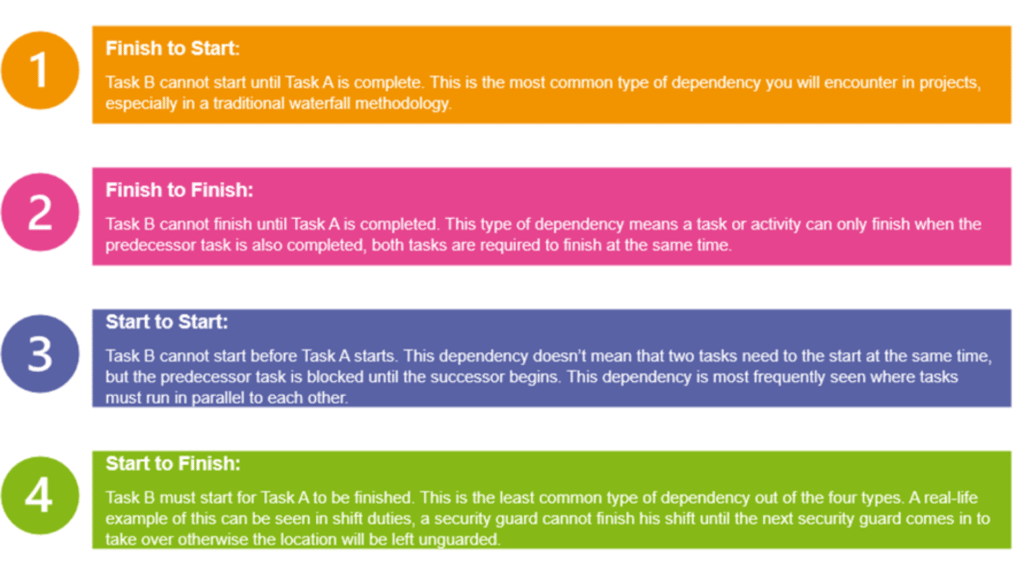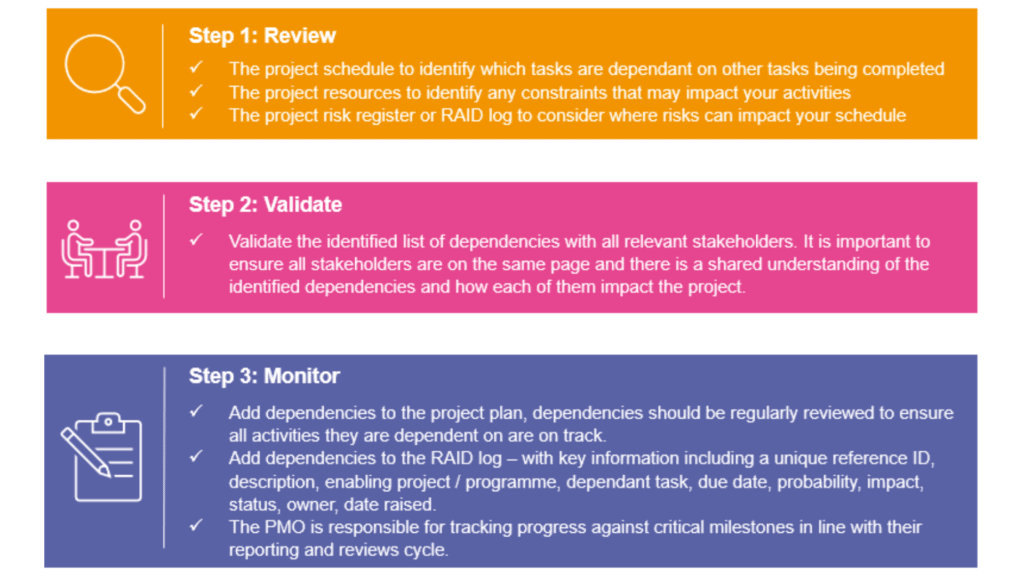Project dependencies are defined as “asks that require input from other tasks to be completed, or activities that can’t start until a previous activity is done” (Prince 2).
What are project dependencies?
Imagine you are making yourself a cup of tea. In order to get to the finished product, your cuppa, you will need to turn on the kettle, get a mug out of the cupboard, put the tea bag in the mug and pour the hot water, etc. The first task relies on another before it can start or finish. You can’t pour the hot water into the mug if you haven’t turned on the kettle to start with. All of these activities are dependencies, they are interconnected tasks that will lead you to your finished product. The same logic applies to projects – no project activity or task exists in isolation.
Examples of dependencies in projects:
- Sending out supplier communications is dependent on formal sign off from the Head of Procurement
- End-users trying to log onto a new system are dependent on the IT team granting access to the system
- Test scripts must be written before system testing can begin
Dependency management is the practice of managing all the interrelated tasks to ensure the project is delivered to the require scope, time and budget. Where dependencies are managed across a programme or portfolio, this is referred to as interdependency management.
Why is dependency management important?
Dependency management is a vital part of any project – it can mean the difference between success or failure. There are three key reasons as to why dependency management is important:
- Critical Path
The critical path is a set of tasks that need to be finished in order to complete the project within expected timelines. For the critical path to be identified, it is critical to understand the full list of all the tasks required to complete the project, the dependencies between the tasks and time needed for each task.
- Improved understanding of the project schedule
Due to the unified nature of the tasks, if a predecessor task is delayed, this will have a direct impact onto successor tasks. If dependencies are managed properly, changes in the schedule will be identified sooner, meaning they can also be addressed sooner to avoid any further delay. On the contrary, if the predecessor tasks finish sooner than anticipated, the successor tasks can start earlier to finish ahead of schedule.
- Prevent resource conflicts
Where there are shared resources between projects or the resource has a day job alongside the project, the project may not have access to the resource until previous tasks are completed. Dependency management in this context is important to help avoid scheduling resources to support on multiple tasks simultaneously.
Types of dependencies – task relationships
In the world of Microsoft Project, there are four different task relationships where there are two different tasks involved. These include:

Internal and external dependencies
When looking at dependencies across the project, it is also important to consider both internal and external dependencies.
Internal dependencies refer to the tasks that are within the project. For example, the testing team cannot test the system until the technical team build the system.
External dependencies refer to factors which are outside the control of the project team. These types of dependencies are more likely to be forgotten about, but they can still impact the delivery of a project. For example, there is a high probability that the PMO (Project / Programme / Portfolio Management Office) will have their own reporting standards that projects must meet, projects will need to obtain the formal sign-off required before they can move into the next stage of the project lifecycle.
Who is responsible for managing dependencies
Typically, the Project Manager is responsible for dependency management. If the organisation has a PMO, the services of the PMO can be enlisted to facilitate and manage external dependencies whilst the Project Manager manages internal dependencies.
Explore our PMO services at Nine Feet Tall.
How do you capture and monitor dependencies?

We hope you enjoyed this blog on dependencies in project management and found some useful information and ideas. For more information on dependency management, please contact us here.


